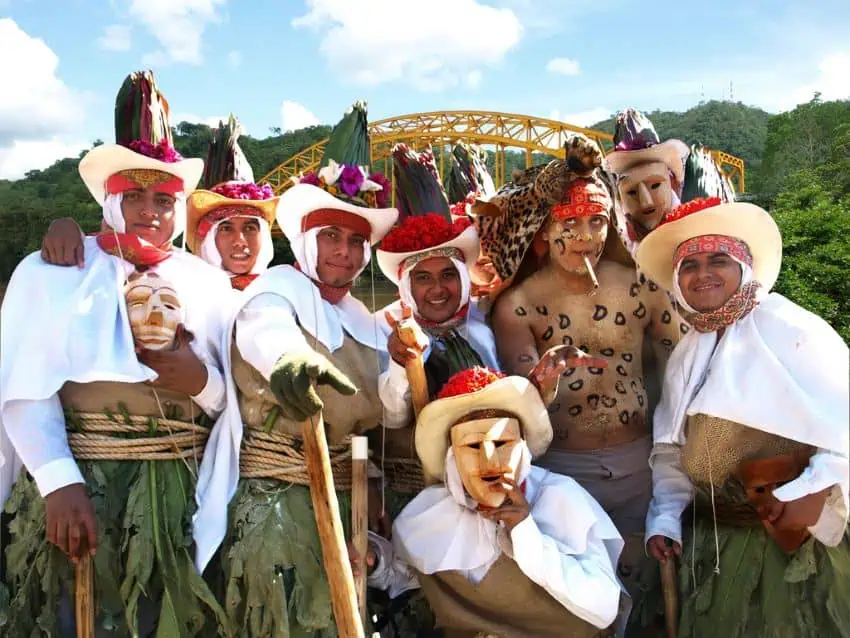A tiny municipality in Tabasco, southern Mexico, might just be the home of one of the world’s most unique festivals: attendees end up covered in flour, eggs and water, and dance dressed up as jaguars and wooden figures.
In Tenosique, Carnival centers on the dance of El Pochó, which symbolizes the eternal struggle between good and evil. Involving different characters, floats, dances, live performances and rituals, this celebration is rooted in Maya traditions dating back to pre-Columbian times.

Tenosique is a municipality in the southernmost part of Tabasco, bordering Guatemala. It is home to Maya ruins like the Pomoná Archaeological Zone, which contains six architectural complexes surrounded by a lush tropical forest.
The festival takes place every year from Jan. 19 until Shrove Tuesday, which is the Tuesday following the second Saturday in February, also known as Fat Tuesday or Mardi Gras. Carnaval follows the lunar calendar, meaning the festival’s length varies each year.
Like most traditions in Mexico, the Tenosique Carnival is an example of syncretism between pre-Columbian and Catholic traditions. It begins with families gathering in the central park of Tenosique, where they pray in honor of Saint Sebastian before throwing flour at one another, as a symbol of hope that there will be a good wheat harvest. This peculiar practice originates from an old religious custom of sprinkling flour at the feet of the image of Saint Sebastian during pilgrimages.
Following the inaugural ritual comes the dance of El Pochó, which happens over the weekends. In Tabasco, El Pochó is regarded as one of the most meaningful dances from the pre-Columbian era.
“It is a unique spectacle,” Tomás Pérez Suárez, a renowned archeologist from Tabasco has said regarding the dance. “[El Pochó] is the highlight of the carnival: is the myth of eternal return, the belief that one born, grows, ages, dies and is reborn.”
Although it has evolved over the years, the dance of El Pochó has maintained its rich cultural roots, including its characters and the costumes they wear. It has remained a symbol of identity for the people of Tenosique.
The dance starts with participants dancing through the town’s streets dressed up, representing three characters: Cojóes, Pochoveras and jaguars.
Cojóes are men born from corn pulp. According to legend, they offended the god Pochó, who turned them into wooden figures. Their costumes feature a skirt made of chestnut leaves, boots made from dried banana leaves and a henequen sack covering the torso. They also wear a wooden mask, a hat covered in foliage and flowers and a white cloak and carry a rainstick called a shiquish. They’re regarded as the life of the party and the central character of the carnival.
View this post on Instagram
Pochoveras, on the other hand, are the flower maidens and priestesses of the god Pochó. They’re responsible for keeping the fire lit and watching over his altar. While dancing, they carry a red flag decorated with tulips that represents Pochó himself.
Finally, jaguars are adults and children that dress up as — you guessed it —jaguars. Also called tigers, they cover their bodies with a white earthy sand called sascab, on which they paint black spots with charcoal that resemble jaguar fur. They also cover their backs with jaguar or deer skin. The story says that jaguars were sent to earth by the god Pochó to maintain equilibrium on earth.
The narrative of the dance tells of an alliance between these three groups to defeat Pochó, who symbolizes death. It begins with the Pochovera priestesses, who keep watch over the Cojóes on behalf of the god. The irreverent Wooden Men challenge Pochó’s power, swaying the priestesses. The god sends the jaguars to restore order, but they are defeated by the Cojóes and turned into allies in the fight to overcome Pochó. On Shrove Tuesday, the Cojóes burn Pochó in effigy, symbolizing the final triumph of good over evi.
With reports from TV Azteca and El Heraldo de Tabasco
